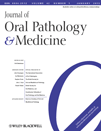Phospholipase C-γ1 expression correlated with cancer progression of potentially malignant oral lesions
Abstract
Background: Phospholipase C-γ1 (PLCγ1) is required for cellular migration during tumor progression and invasion of oral squamous cell carcinoma (OSCC) cells. The objective of the current study was to determine immunoexpression pattern of PLCγ1 in oral potentially malignant lesions (OPLs) and evaluate PLCγ1 usefulness as a biomarker for predicting clinical behavior in the carcinogenesis of OPL.
Methods: In a retrospective follow-up study, the expression pattern of PLCγ1 protein was determined using immunohistochemistry in samples from 68 patients, including untransformed cases (n = 38) and malignant-transformed cases (n = 30). The corresponding post-malignant lesions (OSCCs) were also performed.
Results: We observed that elevated expression of PLCγ1 in 40 of 68 (59%) general OPLs and 23 of 30 (77%) OSCCs compared with that in normal oral mucosa. Kaplan–Meier analysis revealed that patients with PLCγ1 positivity had a significantly higher incidence of OSCC than those with PLCγ1 negativity. Cox regression analysis revealed that PLCγ1 expression patterns were significantly associated with increased risk of malignant progression. In addition, the correlation between PLCγ1 expression in pre-malignant OPL and that in post-malignant OSCC was significant (P = 0.004).
Conclusion: These data indicate that PLCγ1 expression in OPL correlated with oral cancer progression, and PLCγ1 may serve as a useful marker for the identification of high-risk OPL into OSCC.




